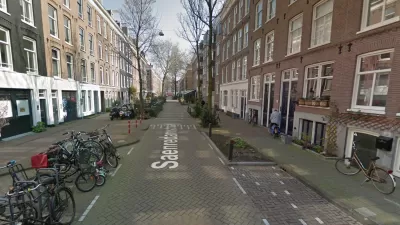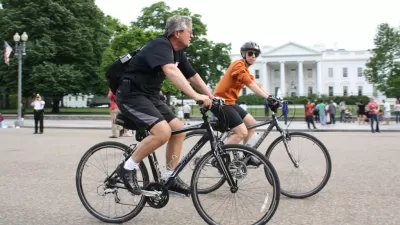As part of a broader effort to encourage less vehicular traffic city-wide, D.C. is expanding permit parking and reducing on-street parking in some of the city's most crowded neighborhoods. Not all are happy with the changes, reports Tim Craig.
In rapidly developing neighborhoods such as Columbia Heights, Adams Morgan, and the U Street Corridor, the D.C. Department of Transportation (DDOT) is eliminating half of visitor parking spaces on weekdays to make sure there is enough parking for residents. "There are only so many parking spaces on streets, and eventually there is going to be a time when the numbers don't add up anymore or demand way overexceeds supply and we have a problem," said Angela Rao, manager of the District's parking and streetlight program. DDOT is also considering community requests to extend this restriction over the weekend in congested Ward 1 neighborhoods.
Other transit changes to come include creating bicycle lanes and setting aside hundreds of metered parking spaces for the disabled. "The restrictions are a slice of a city strategy to promote bicycling and mass transit while increasing the odds that residents can find parking," explains Craig.
Concerns have been voiced by council member Marion Barry who said, "We need bike lanes, but we also need parking," and Craig points out that "the new regulations could add more confusion to the array of parking restrictions that at times baffle even DDOT officials." However, Mayor Vincent C. Gray has set a goal of having 75 percent of all trips in the city take place on foot, bicycle or public transportation by 2032. His communications director Pedro Ribeiro said, "It's not just about creating as much parking as possible. The city is growing, and if every single one of these new residents had a car, there wouldn't be enough parking for everyone, so the idea is to build neighborhoods where you don't need a car."
From the opposing view, resident Anita Taliferro Swanson and her husband Gregory Swanson doubt that the changes will improve parking problems and create walkable communities. She said, "We remember when everyone promised the construction of Metro would cause parking to get better. But how are you going to tell people in America to give up their car?"
FULL STORY: D.C. implementing parking rules to limit visitor spots, discourage driving

Alabama: Trump Terminates Settlements for Black Communities Harmed By Raw Sewage
Trump deemed the landmark civil rights agreement “illegal DEI and environmental justice policy.”

Study: Maui’s Plan to Convert Vacation Rentals to Long-Term Housing Could Cause Nearly $1 Billion Economic Loss
The plan would reduce visitor accommodation by 25% resulting in 1,900 jobs lost.

Why Should We Subsidize Public Transportation?
Many public transit agencies face financial stress due to rising costs, declining fare revenue, and declining subsidies. Transit advocates must provide a strong business case for increasing public transit funding.

Wind Energy on the Rise Despite Federal Policy Reversal
The Trump administration is revoking federal support for renewable energy, but demand for new projects continues unabated.

Passengers Flock to Caltrain After Electrification
The new electric trains are running faster and more reliably, leading to strong ridership growth on the Bay Area rail system.

Texas Churches Rally Behind ‘Yes in God’s Back Yard’ Legislation
Religious leaders want the state to reduce zoning regulations to streamline leasing church-owned land to housing developers.
Urban Design for Planners 1: Software Tools
This six-course series explores essential urban design concepts using open source software and equips planners with the tools they need to participate fully in the urban design process.
Planning for Universal Design
Learn the tools for implementing Universal Design in planning regulations.
Caltrans
Smith Gee Studio
Institute for Housing and Urban Development Studies (IHS)
City of Grandview
Harvard GSD Executive Education
Toledo-Lucas County Plan Commissions
Salt Lake City
NYU Wagner Graduate School of Public Service




























